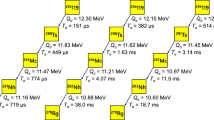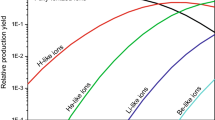Conclusions
A source with thermal ionization in a cavity is extremely convenient for obtaining ion beams with an ultralow quantity of the starting material. Its efficiency with ionization potentials of the starting atoms Vi<6 eV is equal to ≃100% and drops to ≃1% for Vi=8 eV [7]. This makes it possible to use it in the study or more than two-thirds of the periodic system of elements, including the actinides. Thus for ≃1012 uranium and plutonium atoms β*⋍9% and 50%, respectively; for ≃106 curium atoms β*⋍70%; and, for ≃105 californium atoms β*⋍37% [13]. It was shown in [14] that this source can be successfully used in mass spectroscopy to analyze trace quantities of different elements in the solid phase. With its help yttrium isotopes with τ1/2=0.4 sec were detected in [16].
This source is now widely used in our country, where with its help tens of new isotopes have been discovered [15, 17], and abroad (for example, [16]). The source is effective for short-lived isotopes with τi/τ1/2<10 and Vi<7 eV. To study isotopes with τi/τ1/2<10 and Vi>7 eV but with τi/τ1/2>10 it is desirable to develop sources with thermal and photoionization in the cavity. For elements whose atoms have a long residence time on the surface, these sources, just as the gas-discharge sources, are inefficient. Means must be developed for raising the rate of desorption of the indicated atoms from the surface within the framework of the techniques examined here.
Similar content being viewed by others
Literature Cited
R. Kirchner, “Progress in ion source development for on-line separators,” Nucl. Instrum. Methods,186, 275–293 (1981).
R. Arlt et al., “Isobars from the spallation reaction for nuclear spectroscopy,” ibid.,102, 253–256 (1972).
A. Lyatushinski et al., “Methods for preparing short-lived separated isotopes of rare-earth elements,” Preprint No. 6-7469, Joint Institute of Nuclear Research, Dubna (1973).
V. A. Karnaukhov and L. A. Petrov, Nuclei Far from the Beta-Stability Line [in Russian], Énergoizdat, Moscow (1981).
É. Ya. Zandberg and N. I. Ionov, Surface Ionization [in Russian], Nauka, Moscow (1969).
G. Byer et al., “New method for rare-earth isotope separation,” Nucl. Instrum. Methods,96, 437–439 (1971).
R. Johnson, A. Bolson, and C. Henderson, “A high-temperature ion source for isotope separators,” ibid.,106, 83–87 (1973).
A. Latuszynski and V. Raiko, “Studies of an ion source with surface-volume ionization,” ibid.,125, 61–66 (1975).
V. Afanas'ev, V. Obukhov, and V. Raiko, “Thermoionization efficiency in the source cavity,” ibid.,145, 533–536 (1977).
V. P. Afanas'ev and V. A. Obukhov, “Escape of radioactive nuclei from target-sources with surface ionization during operation of the mass-separator with a beam,” Preprint R13-11698, Joint Institute of Nuclear Research, Dubna (1978).
V. I. Balykin, G. I. Bekov, V. S. Letokhov, and V. I. Mishin, “Laser detection of single atoms,” Usp. Fiz. Nauk,132, No. 2, 293–344 (1980).
A. Bystrov, A. Latuszynski, V. Raiko, and H. Tyroff, “A versatile ion source for radioactive isotope separation,” Proceedings of the 2nd Int. Conf. on Ion Sources, Vienna (1972), pp. 850–855.
G. Byen et al., “A nighly effective method for separation of actinide isotopes,” Radioanal. Lett.,12, (4–5), 259–269 (1972).
V. V. Kalygin et al., “Ion source for microquantitave isotopic analysis of transuranium elements,” Prib. Tekh. Eksp., No. 4, 171–173 (1980).
R. Arl't et al., “Results of studies of isotopes outside of the beta-stability band-progress in the YaSNAPP program at the Laboratory of Nuclear Reactions at the Joint Institute of Nuclear Research. Part 1,” Fiz. Element. Chastits At. Yadra,5, No. 5, 843–891 (1974).
H. Rawn, “Experiments with intense secondary beams of radioactive ions,” CERN-EP/79-35 (1979), p. 77.
V. P. Afanas'ev et al., “Investigation of alpha decay of short-lived isotopes,” Preprint No. 532, Leningrad Institute of Nuclear Physics, Leningrad (1979).
Yu. V. Kuznetsov, G. F. Malyshev, and G. G. Telegin, “Effect of excited states of atoms on their surface ionization,” in: Metastable States of Atoms and Molecules and Methods for Studying Them [in Russian], Cheboksary State Univ. (1982). pp. 43–50.
Additional information
Translated from Atomnaya Énergiya, Vol. 60, No. 2, pp. 114–119, February, 1986.
Rights and permissions
About this article
Cite this article
Obukhov, V.A., Raiko, V.I. Methods for preparing ions of short-lived isotopes. At Energy 60, 139–146 (1986). https://doi.org/10.1007/BF01371179
Received:
Issue Date:
DOI: https://doi.org/10.1007/BF01371179




